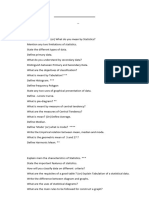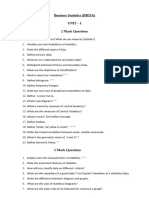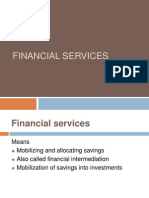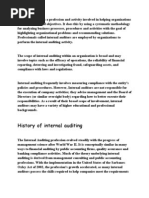Demand Project 11th C
Demand Project 11th C
Uploaded by
T Divya JyothiCopyright:
Available Formats
Demand Project 11th C
Demand Project 11th C
Uploaded by
T Divya JyothiOriginal Description:
Original Title
Copyright
Available Formats
Share this document
Did you find this document useful?
Is this content inappropriate?
Copyright:
Available Formats
Demand Project 11th C
Demand Project 11th C
Uploaded by
T Divya JyothiCopyright:
Available Formats
CBSE
Question Paper 2019 (Set-1)
Class 11 Economics
Time : 3 Hrs
M.M. : 80
(1 Mark Questions)
1. What is meant by Economics?
2. _______ refer to those cost which do not vary directly with the level of output.
3. When price falls with rise in output ,TR is ________ when MR is 0.
a. Maximum
b. Minimum
c. Zero
d. None of these
4. In case of perfect competition, a firm is in equilibrium when :
a. MC = MR
b. MC cuts MR from below
c. MC is rising when it cuts MR
d. All of these
OR
Define short run production function.
(3 Marks Question)
5. List three determinants affecting market demand.
6. Explain the central problem of what to produce in an economy.
OR
Give any three differences between Micro Economics and Macro Economics.
(4 Marks Question)
7. Discuss the difference between expansion in demand and increase in demand using
diagrams.
8. What is perfect competition? Briefly explain any three features of it.
Material downloaded from myCBSEguide.com. 1 / 4
9. The coefficient of elasticity of supply of a commodity is 2. A seller supplies 20 units of this
commodity at a price of Rs.10 per unit. Calculate the quantity supplied when price rises
by Rs. 2.
OR
Find out the missing values from the following table.
Variable Factor (Units) 0 1 2 3 4 5
TP (Units) - - 10 - 24 -
AP (Units) - - - 6 - 5
MP (Units) - 4 - - - -
(6 Marks Question)
10. Discuss in brief the following concepts : (i) Indifference Curve (ii) Indifference Map, (iii)
Marginal rate of substitution, (iv) Monotonic preference, (v) Budget Set, (vi) Budget line.
OR
What is consumers equilibrium? Explain it in case of two commodities using utility
analysis.
11. Discuss the relationship between:
a. TC, TVC and TFC
b. TR and MR when price falls with rise in output.
12. Explain the implication of “Price Discrimination” feature of Monopoly. Also write the
reasons for emergency of monopoly.
Section B (Statistics)
(1 mark Question)
13. Give the meaning of frequency array.
14. The class midpoint is equal to :
a. The average of the upper class limit and the lower class limit.
b. Th e product of upper class limit and the lower class limit.
c. The ratio of the upper class limit and the lower class limit.
d. None of the above.
15. What are the kinds of frequency distribution?
16. When data are classified on the basis of time, then it is called :
Material downloaded from myCBSEguide.com. 2 / 4
a. Chronological classification
b. Spatial Classification
c. Qualitative Classification
d. Quantitative Classification
OR
A statistical series in which both the upper and lower limits are included in the same
class is called_______________
a) Inclusive series
b) Exclusive series
c) Mid-Value series
d) Cumulative frequency series
(3 Marks Question)
17. Draw a multiple bar diagram form the following data :
Year Sales (Rs.'000) Gross Profit (Rs. '000) Net Profit (Rs'000)
2005 120 30 20
2006 130 40 25
2007 140 50 40
2008 150 60 50
18. Prepare a graph to represent the following data relating to imports and exports from
2001 to 2007 :
Year 2001 2002 2003 2004 2005 2006 2007
Import (Rs.) 20 22.7 38 42.5 52 60.2 65.75
Export (Rs.) 25.2 28 40.1 50.5 66.3 70.9 75.7
OR
What are the advantages of graphics representations of statistical data?
(4 Marks Question)
19. Make a histogram, frequency polygon and frequency curve from the following data :
x 0-10 10-20 20-30 30-40 40-50 50-60 60-70
y 6 16 28 30 24 20 5
OR
Material downloaded from myCBSEguide.com. 3 / 4
Draw the ogives, from the following data and find the median
Weekly Wages 0-20 20-40 40-60 60-80 80-100
No. of Workers 40 51 64 38 7
20. Find the arithmetic mean of the following frequency distribution by short-cut method :
Age (in Years) Below-10 10-20 20-30 30-40 40-above
No. of persons 5 8 12 6 4
21. The following table gives the marks of 59 students in history. Calculate the value of
median and mode.
Marks 0-10 10-20 20-30 30-40 40-50 50-60 60-70
Frequency 4 8 11 15 12 6 3
(6 Marks Question)
22. From the following table, calculate mean deviation from median and mean :
X 10 12 14 16 18 20
F 2 3 6 4 3 2
23. What is correlation? W hat are the three types of correlation? Illustrate any two
importance of it.
OR
Calculate the Karl Pearson's coefficient of correlation of the data given below by step
deviation method :
X 55 60 80 70 65
Y 40 45 55 55 40
24. Compute Paasche’s and Laspeyre's index numbers from the following data :
Base Year Current Year
Commodities Quantity Price Quantity Price
A 10 10 20 15
B 3 25 5 10
C 4 20 10 15
D 15 5 18 7
E 2 30 4 30
Material downloaded from myCBSEguide.com. 4 / 4
You might also like
- Mean, Median and Mode - Module1Document8 pagesMean, Median and Mode - Module1Ravindra Babu100% (1)
- Data Interpretation Guide For All Competitive and Admission ExamsFrom EverandData Interpretation Guide For All Competitive and Admission ExamsRating: 2.5 out of 5 stars2.5/5 (6)
- Business Statistics QBDocument12 pagesBusiness Statistics QBRathi KNo ratings yet
- Cbse 11 Statistics Full Course AssignmentDocument3 pagesCbse 11 Statistics Full Course AssignmentSuhaani KhandharNo ratings yet
- BST Unit Wise QPDocument13 pagesBST Unit Wise QPDivya DCMNo ratings yet
- Mock Paper 2 StatisticsDocument5 pagesMock Paper 2 StatisticsAHMED AlpNo ratings yet
- ASSIGNMENTDocument3 pagesASSIGNMENTSam Nirmal PandianNo ratings yet
- BBS 1st Business-StatisticsDocument53 pagesBBS 1st Business-StatisticsGulshan singhNo ratings yet
- Model Question For BBM 3rd SemesterDocument23 pagesModel Question For BBM 3rd SemesterRijan ThapaNo ratings yet
- 11th Holiday HomeworkDocument4 pages11th Holiday Homeworkz.viraj71No ratings yet
- Computer Lab - Practical Question Bank Faculty of Commerce, Osmania UniversityDocument8 pagesComputer Lab - Practical Question Bank Faculty of Commerce, Osmania UniversitySaif Uddin100% (1)
- Class 11 Sample Papers Economics 2023 2Document5 pagesClass 11 Sample Papers Economics 2023 2Avcel100% (1)
- Economics Sample Papers IIDocument5 pagesEconomics Sample Papers IIMaithri MurthyNo ratings yet
- 2 MQP 40Document5 pages2 MQP 40a20755064No ratings yet
- Mean, Median and Mode - Module 1Document8 pagesMean, Median and Mode - Module 1Ravindra Babu0% (1)
- Economics Model Question Paper-2024Document7 pagesEconomics Model Question Paper-2024kvaignaviNo ratings yet
- Business Statistics Practice QuestionsDocument8 pagesBusiness Statistics Practice Questionschethan jagadeeswaraNo ratings yet
- Business StatsDocument11 pagesBusiness StatsLogeshwary bNo ratings yet
- Economics Test 2Document4 pagesEconomics Test 2prince bhatiaNo ratings yet
- Copy 11 QP Eco A PT 4 2022-23Document15 pagesCopy 11 QP Eco A PT 4 2022-23XB 9 Vishwa RajgorNo ratings yet
- Degree Examination - StatisticsDocument3 pagesDegree Examination - StatisticsSabarish SuriyaNo ratings yet
- 11th Eco - Ms - NeelamDocument4 pages11th Eco - Ms - Neelamritesh000dangiNo ratings yet
- Statistics Revision WorksheetDocument2 pagesStatistics Revision Worksheetkaashvi goyalNo ratings yet
- II PU STATISTICSudupiDocument4 pagesII PU STATISTICSudupiCommunity Institute of Management StudiesNo ratings yet
- Bus - Stats Unit-I, II.Q.BDocument4 pagesBus - Stats Unit-I, II.Q.BLogeshwary bNo ratings yet
- II PUC Statistics Paper 2 2020Document4 pagesII PUC Statistics Paper 2 2020Shridhar MNo ratings yet
- 11 Com Set A Summative 1Document2 pages11 Com Set A Summative 1Haseen KumarNo ratings yet
- Statistics Mid24 Iipuc UdpDocument4 pagesStatistics Mid24 Iipuc Udpkaushik4786No ratings yet
- Model Question For BBA BIM and BBM 3rd Sem StatisticsDocument6 pagesModel Question For BBA BIM and BBM 3rd Sem StatisticsSemant BhattaraiNo ratings yet
- Mock Test PractiseDocument6 pagesMock Test Practisevijaylaxmimudliar2006No ratings yet
- Bcom 3 Sem Quantitative Techniques For Business 1 22100579 Apr 2022Document3 pagesBcom 3 Sem Quantitative Techniques For Business 1 22100579 Apr 2022Drisya SureshNo ratings yet
- KK Public Economics Class XiDocument8 pagesKK Public Economics Class XiUtkarsh GuptaNo ratings yet
- 3 Honours Excel Practical ListDocument8 pages3 Honours Excel Practical ListBala KrishnaNo ratings yet
- 492_1643636271_280Document3 pages492_1643636271_280pavanh045No ratings yet
- 11 Economics Sp01Document18 pages11 Economics Sp01DYNAMIC VERMANo ratings yet
- New Stats QUETIONSDocument2 pagesNew Stats QUETIONSbaranidharan .kNo ratings yet
- 11 Economics SP 02Document15 pages11 Economics SP 02MOHAMMAD SYED AEJAZNo ratings yet
- TSS - Grade11 - Economics Term-2 (2023-24) Revision SheetDocument5 pagesTSS - Grade11 - Economics Term-2 (2023-24) Revision Sheetastro gamerNo ratings yet
- Business StatsDocument3 pagesBusiness Statssaha apurva100% (1)
- 3BS (G)Document7 pages3BS (G)Vijay KrishnaNo ratings yet
- UG Model QP MergedDocument93 pagesUG Model QP MergedvineethkmenonNo ratings yet
- CBSE Class 11 Economics Sample Papers 03: Material Downloaded From - 1 / 4Document4 pagesCBSE Class 11 Economics Sample Papers 03: Material Downloaded From - 1 / 4Himanshu Nawariya100% (1)
- Statistics AssignmentDocument4 pagesStatistics AssignmentSAMRUDA SADANANDNo ratings yet
- CORE NotedDocument3 pagesCORE Notedminehacks95No ratings yet
- Bcom 3 Sem Quantitative Techniques For Business 1 19102079 Oct 2019Document3 pagesBcom 3 Sem Quantitative Techniques For Business 1 19102079 Oct 2019lightpekka2003No ratings yet
- Problems on Geometric MeanDocument2 pagesProblems on Geometric Meanmuskanfazeelath29No ratings yet
- Practical 1-1 MergedDocument16 pagesPractical 1-1 Mergedpese4095No ratings yet
- Jain College: Date: Dec-2017 Subject: Statistics I Puc Mock Timings Allowed: 3Hrs. Total Marks: 100Document4 pagesJain College: Date: Dec-2017 Subject: Statistics I Puc Mock Timings Allowed: 3Hrs. Total Marks: 100Deepak SalianNo ratings yet
- Arch. Assignments Stat.Document3 pagesArch. Assignments Stat.Anurodh yadavNo ratings yet
- (6426) Revision Worksheet For Cycle Test - Measures of Dispersion Economics - Grade 11F FinalDocument5 pages(6426) Revision Worksheet For Cycle Test - Measures of Dispersion Economics - Grade 11F FinalNoushad AliNo ratings yet
- XII StatisticsDocument4 pagesXII StatisticsMine FollowerNo ratings yet
- LRC EditingDocument4 pagesLRC EditingdeadkillerzenithNo ratings yet
- MOCTDocument5 pagesMOCTrishavNo ratings yet
- Cbse Class 11 Economics 2016Document3 pagesCbse Class 11 Economics 2016Riya JainNo ratings yet
- II Puc Statistics Mid-Term Exam Expected Model QP 2021-1Document3 pagesII Puc Statistics Mid-Term Exam Expected Model QP 2021-1Likith GNo ratings yet
- Business Statistics - III SemDocument14 pagesBusiness Statistics - III SemM.C.Chenbaga neelaNo ratings yet
- Statistics Question BankDocument4 pagesStatistics Question Bankvmarathe1505No ratings yet
- Full Course Exam-XiDocument5 pagesFull Course Exam-Xiarav ahujaNo ratings yet
- Hermann Gmeiner School XI ECO Final Set 1Document4 pagesHermann Gmeiner School XI ECO Final Set 1Lalit NathNo ratings yet
- Andrew Berry Resume 2021Document2 pagesAndrew Berry Resume 2021AndrewRossBerryNo ratings yet
- Pricing For International MarketingDocument44 pagesPricing For International Marketingjuggy1812No ratings yet
- Measuring The Impact of Customer Satisfaction On Profitability: A Sectoral AnalysisDocument11 pagesMeasuring The Impact of Customer Satisfaction On Profitability: A Sectoral AnalysisLongyapon Sheena StephanieNo ratings yet
- invoiceDocument1 pageinvoiceNeil's Physics Pathsaala - NPPNo ratings yet
- ANA Demand Generation PlaybookDocument33 pagesANA Demand Generation PlaybookDemand Metric100% (1)
- Costing QP - Material, Labour, OHDocument10 pagesCosting QP - Material, Labour, OH7358827307sNo ratings yet
- Testing 1,2,3Document297 pagesTesting 1,2,3Viajes Bernal100% (1)
- Slide TemplatesDocument882 pagesSlide TemplatesSpil_vv_IJmuiden33% (3)
- Lanny Domangue Experience Lanny Domangue Brings Years of Experience To Halo, LLC. Brings Years ofDocument1 pageLanny Domangue Experience Lanny Domangue Brings Years of Experience To Halo, LLC. Brings Years ofapi-26723141No ratings yet
- Notes Of: Hindustan College of Science and TechnologyDocument23 pagesNotes Of: Hindustan College of Science and TechnologyShashank SinghNo ratings yet
- Financial SystemDocument36 pagesFinancial SystemSrikanth BalakrishnanNo ratings yet
- BSSC ChallanDocument1 pageBSSC ChallanVijay Kumar KumarNo ratings yet
- Internationalization Strategy of Labirinto Shoes To Sydney (Australia)Document39 pagesInternationalization Strategy of Labirinto Shoes To Sydney (Australia)Anoosha HabibNo ratings yet
- Msmse GulbaharDocument2 pagesMsmse Gulbaharvanheusen1998No ratings yet
- Datasheet Fortigate 110CDocument2 pagesDatasheet Fortigate 110CSergio FrançaNo ratings yet
- MM ZG523Document13 pagesMM ZG523Prakash Kumar SenNo ratings yet
- Comviva CS Managed Services V1.0Document15 pagesComviva CS Managed Services V1.0Dr.Sreekala PillaiNo ratings yet
- Cover Letter For Post of Business Process Improvement CoordinatorDocument3 pagesCover Letter For Post of Business Process Improvement Coordinatorsandeep salgadoNo ratings yet
- Advantage & Disdvantage of FIFO, LIFO & Weight AverageDocument8 pagesAdvantage & Disdvantage of FIFO, LIFO & Weight AverageRozana Zakir ManNo ratings yet
- Customer Focus MindsetDocument4 pagesCustomer Focus MindsetsongaonkarsNo ratings yet
- Test 2 N Answer ECO556 Dec2016Document9 pagesTest 2 N Answer ECO556 Dec2016Jai ToneExcelNo ratings yet
- Audit ProjectDocument14 pagesAudit ProjectDhara Mehta100% (1)
- Pepsi PakistanDocument7 pagesPepsi PakistanfujimukazuNo ratings yet
- 24jan2011Document8 pages24jan2011Sanusi KasimNo ratings yet
- Cease & Desist REPLY From NAKED GRANOLA To BEAR NAKEDDocument14 pagesCease & Desist REPLY From NAKED GRANOLA To BEAR NAKEDNaked GranolaNo ratings yet
- Avighna Permit SQ 02-11-15Document3 pagesAvighna Permit SQ 02-11-15Pragathees WaranNo ratings yet
- Bonrostros - Metrocast - BJDCDocument6 pagesBonrostros - Metrocast - BJDCLucille ArianneNo ratings yet
- Wacc CalculationsDocument106 pagesWacc CalculationsRishi BhansaliNo ratings yet
- Hero Honda-Consumer Buying BehaviourDocument65 pagesHero Honda-Consumer Buying Behaviourharinarola75% (12)
- The Edge Singapore Online Media Kit 2010Document12 pagesThe Edge Singapore Online Media Kit 2010Mi-Mi ChaiNo ratings yet

























































































